
All categories
Featured selections
Trade Assurance
Buyer Central
Help Center
Get the app
Become a supplier

(30461 products available)





















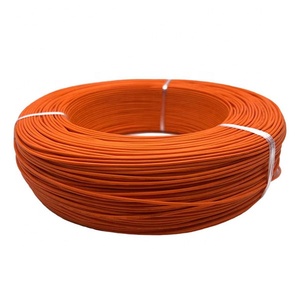
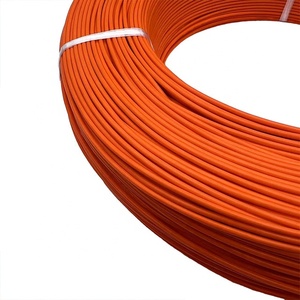













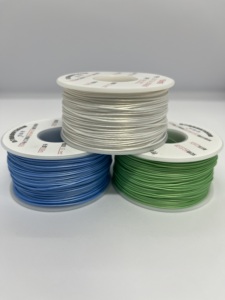
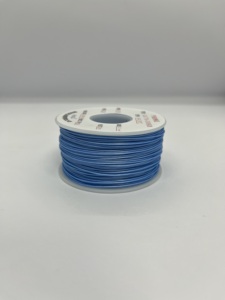







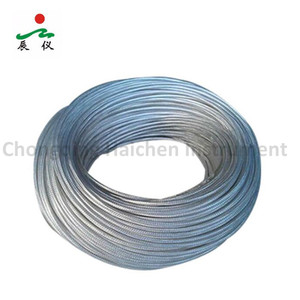

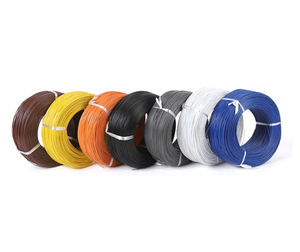
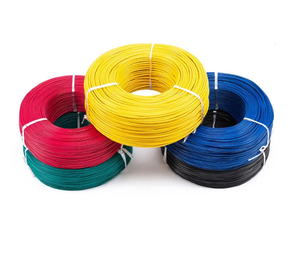



PTFE Teflon cables are available in a variety of forms that are each appropriate for particular purposes. These convenient, adaptable cables are perfect for precise work because of their insulation, great heat resistance, and durability. Below is a detailed overview of the most common PTFE Teflon cable types, as well as their key features and applications.
PTFE Teflon cables for high temperatures can tolerate higher than normal temperatures, which is one of their main advantages. These cables are made using unique polymers that can endure temperatures of over 200 oC. These cables are used widely in the aerospace, automotive, and chemical industries, where temperature control is ineffective. These are big boons to engineers and plant managers, as well as technicians, when choosing cabling components due to their durability and dependability.
The Coated Teflon cables have other materials reinforcing their durability, the common one being copper. A common practice is to coat these cables in Teflon to provide extra insulation. In such cases, these cables may have additional strengths such as electrical insulation or extra mechanical protection necessary in an industrial setup. What stands out in this wiring is its commercial applicability in sectors like electronics, where a premium is placed on compact, reliable wiring.
If flexibility is at a premium, stranded PTFE Teflon cables come in handy. The design construction of these cables uses many small strands instead of a solid wire. As a result, such cables can be modulated and navigate within machinery that has slight bends. This property is especially needed in fields such as robotics and medical equipment. Users of these machines appreciate the flexibility inherent in the cable given their need for frequent, safe, and efficient functioning with minimal risk of wire breakage in their equipment.
Personalized PGTEF Hook-Up Wire is designed for distinct applications. It is used more often in electronics as this one's light and seems to be the right balance between resistance and flexibility. This wire is excellent for wiring circuits and other electronic devices. Its small size and great electrical resistance suitability make it usable within crowded circuit boards without succumbing to failure under excess heat or electrical current. This wire is common in the medical, telecommunications, and consumer electronics industries due to its versatility and high performance.
In the aerospace industry, PTFE Teflon cables are used because of their high heat and corrosion resistance.
The chemical industry utilizes these cables for safety in transporting chemicals due to their exceptional durability.
Electronics depend on PTFE insulation for reliable performance in high-frequency applications.
Robotics and medical equipment employ stranded PTFE cables to ensure flexibility in tightly packed systems.
Automotive applications frequently use PTFE wires in engine compartments for heat resistance.
A close look into what sorts of materials go toptfe teflon insulated cablesand the ways the cable run can remain sustainable and dependable in the long haul leads one to consider durability. PTFE, popularly referred to as Teflon, is a tough and extremely stable material that, among others, offers insulation to these cables. This segment will review the components of these wires and how durability can enhance performance and reliability.
PTFE insulation comes with properties characterized by high temperature, chemical inert, and very durable. It is, therefore, suitable for use in extreme conditions such as high heat and direct exposure to corrosive substances. This ensures thermal stability over the years and makes for very reliable chemical resistance cables. Such parameters revealed are essential not only in plant operations but also in folks in professions who use these cables on a day-to-day basis—in medical, automotive, and aerospace applications.
PTFE Teflon cables' inner conductors are typically copper, a metal with great conductivity for electrical uses. Copper wires' physical and electrical properties make them ideal for transporting electrical currents with minimal resistance. In most cases, stranded copper or tinned copper variety is used, enhancing the cable's durability and corrosion resistance.
Exemplarily long-lasting, PTFE Teflon cables can handle harsh environments for extended periods without losing functioning. The exceptional chemical and thermal resistance of this material makes it ideal for use in industries where operant conditions regularly degrade other electrical wires. It is in these industries—like chemical processing or space exploration—that this durability is essential—that downtime due to cable failure is unacceptable; hence, this TEFLON Cable has great endurance.
In certain instances, PTFE Teflon cables also feature additional jackets made of other robust polymers. Such protective layers give added mechanical protection against abrasion, impact, and even routing or dressing mishaps. Over the years, this extra protection has significantly increased the cable's lifespan, making it employable in industries with adverse physical working conditions.
The PTFE TeflonCables' durability results from their exceptional thermal and chemical resistance, copper conductors, and optional protective jacket. In industries where dependability and longevity are essential, these cables' high-quality materials and robust design make them handy. In industrial settings with hazardous environments, engineers, maintenance teams, and technicians depend on PTFE Teflon cables to perform well and resist wear over time.
PTFE Teflon cables find a wide variety of uses in commercial settings, each valued for their terrific insulating properties, flexibility, and durability. This section explores how and where these cables are used in activities and industries that require reliable performance.
These PTFE cables are primarily used in the aerospace industry because they remain stable even in extreme heat and pressure. Therefore, they are used in critical wiring systems, avionic instruments, and satellite technology. These cables' lightweight and reliable electrical insulation make them essential components in aviation systems. It is no surprise that aerospace engineers seek these cables to enhance performance, decrease weight, and boost dependability.
Thanks to their biocompatibility, heat resistance, and shape retention, these cables have become a critical component of medical equipment. Surgeons' Catheters, diagnostic instruments, and laser surgery machines use these wires. Their insulation provides reliable electrical shielding with no signal degradation, which is very crucial for precision in medical diagnostics and treatments. Hospitals and clinics place a premium on the quality of these cables in environments where they need to function quickly and safely.
Stranded and flexible PTFE cables are perfect for industrial robots and machinery wiring. This versatility allows these cables to be routed around moving parts and mechanisms. PTFE cable insulation holds up to the friction, heat, and chemical exposure commonplace in manufacturing environments. Manufacturing and robotics engineers choose these durable cables to maintain system uptime and minimise the need for routine repairs.
These cables are suitable for many telecommunications applications, such as antennae and microwave transmission lines. Their outstanding electrical insulating property keeps them signal interference-free, significantly increasing communication system performance. They work well in RF and microwave technologies because of their low loss and durability. Hence, cable quality becomes vital for telecom engineers and technicians, ensuring system reliability in different weather conditions.
Selecting the proper PTFE Teflon cable entails considering various factors that impact the hardware's overall performance and dependability. These self-evident factors presently weave into the fabric of industrial and commercial operation from diverse academic and occupational viewpoints. Temperature range, cable flexibility, and diameter are critical in determining the Teflon cable's correct implementation.
First, it is important to consider the PTFE Teflon cable's temperature range. Unlike normal electrical wires, these cables withstand much heat due to their unique insulation. If an industry deals with extreme temperatures, choosing a cable that can withstand this heat wave is best. Aerospace and chemical companies often find themselves in such hot conditions. Engineers handling electrical components should know the Teflon cable's temperature range to avoid breakdowns and system failures.
Cable flexibility is crucial for applications where wiring needs to bend or move regularly, like in robotics or medical devices. Stranded PTFE cables are more flexible than solid ones, making them suitable for tight spaces or moving parts. Choosing the correct cable diameter ensures the wiring fits within the specified design constraints without compromising electrical performance. This consideration prevents over-engineering solutions that take up unnecessary space and ensures efficient system design.
The cable's electrical rating must match the application's voltage and current requirements to ensure reliable performance. Using a cable with improper ratings can cause system failures. Finally, the application's chemical resistance needs to be factored in. PTFE Teflon cables, in particular, work marvelously where corrosive chemicals are abundant. One must select a cable that has the right degree of chemical resistance so that its insulation will not wear out and the electrical performance will not deteriorate.
Evaluating temperature range, flexibility, electrical ratings, and chemical exposure when selecting PTFE Teflon cables ensures the proper application. People in different industries, from aerospace to robotics, need dependable, long-lasting wiring to perform well in tough situations. Choosing the right cable reduces downtime and enhances operational effectiveness.
A1: PTFE Teflon cables are suitable for harsh environments because of their insulation heat and chemical resistance. Hence, they last longer in extreme conditions than other cables.
A2: Most certainly, they are flexible. They do maintain their shape while bending, and that is why they remain flexible. It especially comes in handy for robotic and medical applications where space is limited.
A3: These cables have various telecom, aerospace, medical, robotics, and chemical processing applications due to their excellent insulating and mechanical properties.
A4: These cables possess great insulating properties for electrical applications. They are particularly suited for high-frequency and low-loss applications like RF and microwave transmission.
A5: PTFE Teflon cables usually use copper for electrical conductors. Copper has good conductivity with PTFE insulation resistant to high temperatures and chemicals.